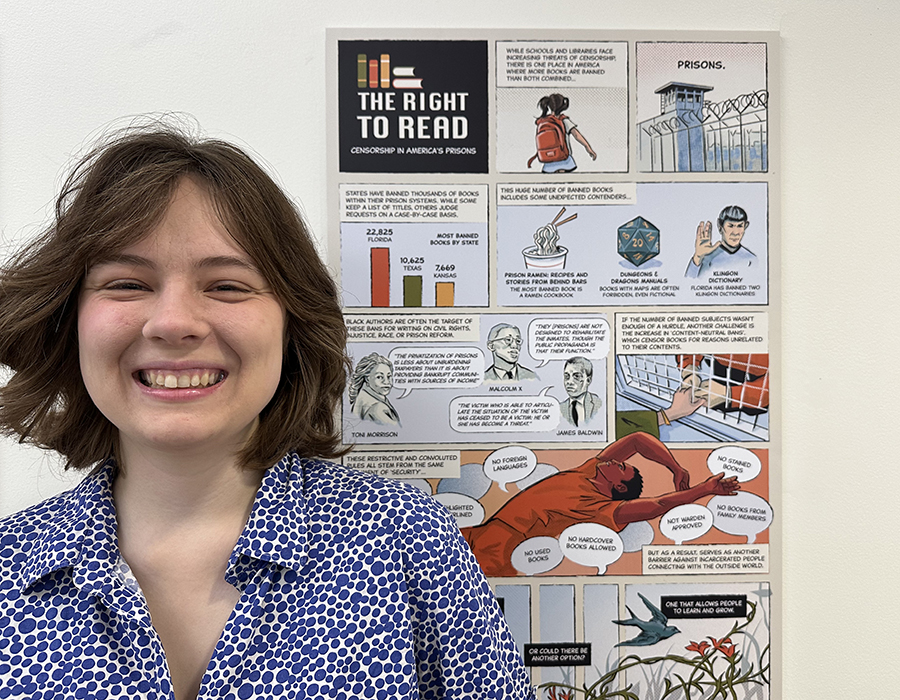Jurgen Comics Contest honorees explore banned art and censorship

Images from the annual Jurgen Comics Contest will be showing on the Cabell Screen through February
This exhibit showcases student artwork from VCU Libraries’ annual Jurgen Comics Contest. The Contest focuses on telling stories of banned art as a way to consider the complex relationship between art and society and the long history of censorship.
Wanda Felsenhardt – “The Right to Read: Censorship in America’s Prisons.” Grand Prize
Wanda Felsenhardt’s comic shines a spotlight on the vast number of titles banned by state prison systems and reasons given for keeping books out of prisoners’ hands.
Felsenhardt is a graduate student studying experience design at the VCU Brandcenter. Reflecting on her award-winning comic, she said, “I enjoyed this process because I learned a lot about a topic I knew nothing about. I had no idea how many restrictions there are around accessing books in prison.” To learn more, Felsenhardt looked to PEN America’s annual report on prison censorship and the Marshall Project’s reporting on book titles that are banned in state prisons. The artist reported, “I also read multiple articles written by formerly incarcerated people, as well as nonprofit leaders dedicated to getting more books in prisons.”
Naomy Cardoso Perez and Gillian Grunenfelder – “Monument Woman” Artistry Award
Their comic tells the story of Nazi attempts to control art and of the bravery of Rose Valland, a French art historian and member of the Resistance, who secretly documented Nazi art theft.
Grunenfelder, a Communication Arts major, remarked, “[M]y partner and I felt that we needed to do [Rose Valland] and her story justice. Every detail, from the medium and visual look of the comic, to the use of quotes from her book, were included with her and the victims of the Degenerate art movement in mind.”
Painting and printmaking major Naomy Cardoso Perez added, “We wanted to show as much information as possible. Our comic panels were created on canvas with acrylic paint and later transferred to digital. We actively chose to keep the texture of acrylic in our work to keep a unique, painterly style. The panel layout was very intentional, to have each piece somehow interact with each other. For instance, we chose to have a large illustration of Rose Valland, holding a camera towards the panels that show the Nazis with stolen art, to symbolically express her efforts as a documenter of the art pieces and where they were being taken.”
Winston Broiles – “Spider-Man, Terror of the Comics Code Authority” Storytelling Award
Winston Broiles’ comic recounts how Spider-Man comics emboldened the comics industry to reject oversight and censorship by the C.C.A.
Broiles,a Communication Arts major, explained, “I’ve always been a big comic book fan.Marvel and DC comics are what inspired me as a child to pursue art as a career. Spider-Man is also a long-time favorite character of mine.”
“The average comic book consumer may not be aware of how the Comics Code Authority massively impacted the way writers and artists were able to tell their stories as the industry grew in popularity,” continued Broiles, “so I thought it was important to educate people about it. My favorite part of this process was finding creative ways to combine the styles and conventions
of Sunday Funnies style comic strips with Silver Age Comic books. I looked to comics such as Calvin and Hobbes, Peanuts, and Pearls Before Swine for inspiration on page layout. However, I wanted to put my own spin on the genre and incorporated classic superhero comic motifs such as halftone dots and bright saturated primary colors.”
Hannah Diment – “Allegory of Artemisia” Research Awa
Hannah Diment’s comic examines the challenges faced by the talented 17th-century woman painter, Artemisia Gentileschi.
Communication Arts student Diment was inspired by her love for art history and her desire to address the lack of women she sees represented in history.
Diment said, “Artemisia Gentileschi’s story stood out among others because historians have villainized and glorified her story to fit their narratives rather than being accurate to Artemisia. [I hope] that this comic will inspire others to think more deeply of historical figures as people rather than just stories…” She added, “I learned recently of the conservation efforts that are being done on Allegory of Inclination, and it inspired me to highlight the censorship in Artemisia’s story. Conservators couldn’t safely remove the addition without damaging Artemisia’s original work underneath. Instead, they used digital imagery to unveil the original figure without the drapery. The original image as Artemisia intended us to see it was revealed just a few days ago, over 400 years after she likely sat and modeled for it herself.”
Cici Eltermann – “America’s Sailor Moon” Honorable Mention
Cici Eltermann, a senior in Communication Arts, looked at changes in the English-language version of a popular Japanese anime. Eltermann said, “When I thought of censorship in the media my mind went immediately to Sailor Moon because (1) it’s an iconic TV show and (2) I love…Naoko Takeuchi’s work. Additionally, while the Americanized script bending is certainly problematic due to its discriminatory nature, I also found it so hilarious that I just had to draw it because—cousins? Really? That was the solution? I hope I conveyed how absurd the whole situation is.”
Ayla Bramblett – “Dystopian University” Honorable Mention
Ayla Bramblett is a student in the art foundation program at VCUarts. She is interested in studying communication arts, while also enjoying photography and ballet. Bramblett experimented extensively with the color scheme for this comic. “I really focused on developing an engaging comic layout, even if it meant I had to draw outside the boxes. To do this I drew on top and layered drawings.”
Categories Comic Arts, Uncategorized